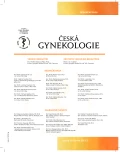Two years of pharmacological termination of pregnancy in the Silesian hospital Opava, success and lessons
Authors:
A. Šefčíková; L. Šimková; A. Dörr
Authors‘ workplace:
Gynekologicko-porodnické oddělení Slezské nemocnice v Opavě p. o., primář oddělení MUDr. A. Dörr, CSc.
Published in:
Ceska Gynekol 2017; 82(3): 206-210
Overview
Objective:
The purpose of this study was to summarize our department‘s experience with pharmacological termination of pregnancy up to 49 days of amenorrhea, to assess the success, and especially, to offer a closer analysis of the complications of this method.
Design:
Retrospective analysis.
Setting:
Department of Gynaecology and Obstetrics at the Silesian Hospital.
Methods:
The monitored sample consisted of 161 female patients who underwent pharmacological termination of pregnancy at our department from 1. 7. 2014 to 30. 6. 2016 being administered 600 mg of mifepristone (Mifegyne) and 400 µg of misoprostol (Mispregnol). Within the sample of patients we observed the objective process of pharmacological termination of pregnancy with special attention being payed to an analysis of complications. We compared the number of complications occurred under classic surgical intervention and those occurred under pharmacological termination of pregnancy.
Results:
A complete abortion without the necessity of surgical intervention occurred with 151 patients (93.79%) of whom 15 patients with administering uterotonic medicaments. Ten patients (6.21%) required a consequent instrumental revision of the uterine cavity, seven of them (70%) had a history of surgical intervention in the uterine cavity. In case of one patient persisted vital pregnancy. Two patients underwent medical termination of pregnancy twice. In one case there were twins.
Conclusion:
The method of pharmacological pregnancy termination has a good efficiency, it is safe with minimal side effects.
Keywords:
medical termination of pregnancy, mifepristone, misoprostol, Medabon
Sources
1. Ashima, T., Vinita, A., Shallini, R. Early medical abortion: a new regimen up to 49 days´gestation. Aust N Z J Obstet Gynaecol, 2005, 45, 2, p. 137–143.
2. Doporučení k provádění prevence RhD aloimunizace u RhD negativních žen. Čes. Gynek, 2013, 78, 2, s. 132–133.
3. Edukační materiál o bezpečném užívání a minimalizaci rizik při použití léčivých přípravků Mifegyne a Mispregnol (ve znění schváleném SÚKL ze dne 11. 11. 2013 a 16. 12. 2013).
4. Fiala, CH., Cameron, S., Carmo-Bombas, T., et al. Early medical abortion: a practical guide for healthcare profesionals, 2012.
5. Frank, K., Gerychová, R., Janků, P., et al. Farmakologické ukončení gravidity mifepristonem a misoprostolem – zhodnocení úspěšnosti, komplikací a spokojenosti pacientek. Čes. Gynek, 2015, 80, 6, s. 451–455.
6. Haimov-Kochman, R., Arbel, R., Brzezinski, A., et al. Risk factors for unsuccessful medical abortion with mifepristone and misoprostol. Acta Obstet Gynecol Scand, 2007, 86, 4, p. 462–466.
7. Li, YT., Hsieh, JC., Hou, GQ., et al. Simultaneous use of mifepristone and misoprostol for early pregnancy termination. Taiwan J Obstet Gynecol, 2011, 50, 1, p. 11–14.
8. Kučera, E. 2011. Umělé přerušení těhotenství. Zdravotnictví a medicína [online]. [cit. 2014-11-22].
9. Odeh, M., Tendler, R., Sosnovsky, V., et al. The effect of parity and gravidity on the outcome of medical termination of pregnancy. Ist Med Assoc J, 2010, 12, 10, p. 606–608.
10. SmPC Mifegyne 200 mg tablety.
11. SmPC Mispregnol 400 µg tablety.
12. SmPC Medabon – kombinované tablety 200 mg mifepristonu a 4 vag. tablety 0,2 mg misoprostolu.
13. Vnitřní doporučený předpis o farmakologickém ukončení těhotenství Gynekologicko-porodnického oddělení Slezské nemocnice v Opavě.
14. Zákon o umělém přerušení těhotenství č. 66/1986 Sb., vyhláška č. 75/1986 Sb.
Labels
Paediatric gynaecology Gynaecology and obstetrics Reproduction medicineArticle was published in
Czech Gynaecology

2017 Issue 3
Most read in this issue
- Complications tension-free vaginal tape surgery
- Current FIGO staging classification for cancer of ovary, fallopian tube and peritoneum
- Hirsutism
- Retrospective analysis of monochorionic twin pregnancies born in the Institute for the Care of Mother and Child between 2012–2015
